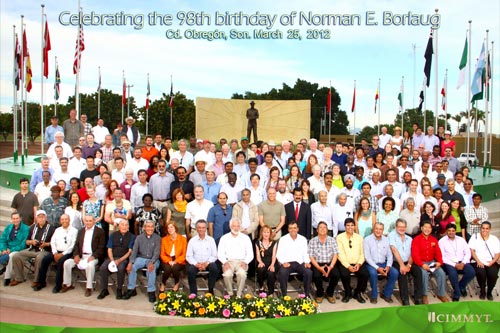NuME set to boost nutrition of Ethiopian children
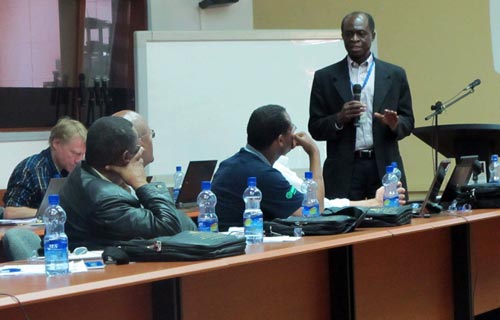 During 26-28 March 2012, CIMMYT scientists, partners, and collaborators met in Addis Ababa, Ethiopia, for the Inception Planning Workshop of the NuME project. NuME (Nutritious Maize for Ethiopia) is a new five-year USD 13 million project that aims to significantly reduce malnutrition, especially among young children, and increase food security and household income of resource-poor smallholder farmers in Ethiopia through the widespread adoption, production, and utilization of quality protein maize (QPM). QPM contains more than twice as much lysine and tryptophan as conventional maize, giving its protein a nutritive value that is roughly 90% that of milk.
During 26-28 March 2012, CIMMYT scientists, partners, and collaborators met in Addis Ababa, Ethiopia, for the Inception Planning Workshop of the NuME project. NuME (Nutritious Maize for Ethiopia) is a new five-year USD 13 million project that aims to significantly reduce malnutrition, especially among young children, and increase food security and household income of resource-poor smallholder farmers in Ethiopia through the widespread adoption, production, and utilization of quality protein maize (QPM). QPM contains more than twice as much lysine and tryptophan as conventional maize, giving its protein a nutritive value that is roughly 90% that of milk.
The project, led by CIMMYT and supported by the Canadian International Development Agency (CIDA), is being implemented in collaboration with the Ethiopian Institute of Agricultural Research (EIAR), the Ministry of Agriculture (MoA), the Ministry of Health, the Ethiopian Health and Nutrition Research Institute (EHNRI), Sasakawa Africa Association (SAA), Sasakawa Global 2000 (SG2000), other NGOs, universities, and public and private seed companies. The purpose of the meeting was to present the approved project to partners; review, organize, and agree on the project’s management structure; review and agree on partner roles and responsibilities; and develop detailed work plans and budgets.
Project coordinator S. Twumasi-Afriyie gave an overview of the status of QPM in Ethiopia and pointed out that NuME was building on the achievements of the previous and largely successful CIDA-funded QPMD project that was implemented in Ethiopia, Kenya, Tanzania, and Uganda during 2003-2010.
Underscoring NuME’s importance, Twumasi said that diets in eastern and central Africa are largely based on maize, for it provides up to 80% of the calories consumed and is a primary weaning food for children. However, it is poor in two essential amino acids, lysine and tryptophan, putting infants who consume maize without protein supplements at risk for malnutrition and stunted growth and development. The problem is more acute in Ethiopia, where 47% of children are stunted, 38% are underweight, and 11% suffer from wasting.
Consequently, the project has targeted areas with high maize production and consumption, areas where farmers grow BH660 or other conventional maize varieties that now have QPM versions, and most importantly, areas with high malnutrition, according to Hugo De Groote, CIMMYT socio-economist.
Andreas Oswald, SAA director of crop productivity enhancement, outlined the strategies planned for demonstrating new QPM technologies, improved crop management practices, and post-harvest handling and processing to farmers, and for improving their knowledge and skills. Increasing the participation of women in NuME activities and identifying ways to ensure that they benefit substantively from QPM technologies are key goals of the project.
The project will also partner with Farm Radio International (FRI), which will work with Ethiopian radio stations to develop a gender sensitive campaign to help women and men farmers gain a better understanding of nutrition and protein, and to raise awareness of QPM and other strategies for improving the nutrition and health of families, especially children.
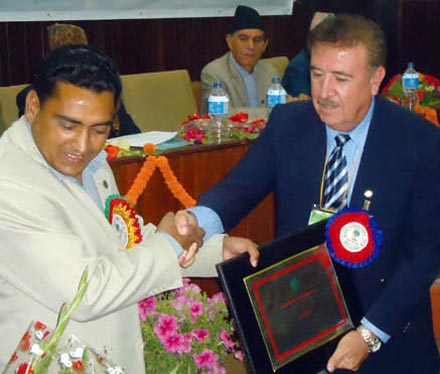 Receiving the prize on behalf of CIMMYT, Nepal country representative Guillermo Ortiz-Ferrara thanked the Society for the recognition. “On behalf of the director general of CIMMYT, Dr. Thomas Lumpkin, the center’s management, and colleagues who have been based in Nepal and the region for more than 26 years, we thank SAS-N for this great honor,” he said. “I would like to give special thanks to the government of Nepal and the MoAC for hosting CIMMYT’s regional office. Finally, we thank the many government and non-government organizations for their long-standing partnership and collaboration.”
Receiving the prize on behalf of CIMMYT, Nepal country representative Guillermo Ortiz-Ferrara thanked the Society for the recognition. “On behalf of the director general of CIMMYT, Dr. Thomas Lumpkin, the center’s management, and colleagues who have been based in Nepal and the region for more than 26 years, we thank SAS-N for this great honor,” he said. “I would like to give special thanks to the government of Nepal and the MoAC for hosting CIMMYT’s regional office. Finally, we thank the many government and non-government organizations for their long-standing partnership and collaboration.”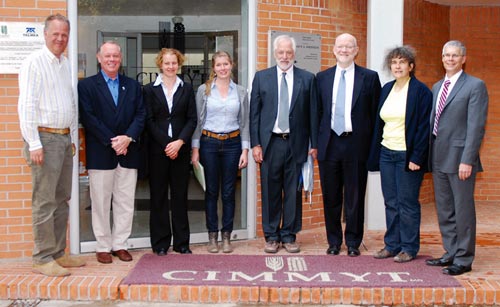 Senior management and center scientists welcomed Chris Elias, the new President of Global Development of the Bill & Melinda Gates Foundation, to CIMMYT headquarters on 30 March 2012, providing among other things an introduction to major programs. Elias’ background includes experience in the global non-profit health sector and most recently as CEO of PATH, a nongovernmental organization whose portfolio includes solutions for AIDS, tuberculosis, and malaria. David Bergvinson, Senior Program Officer for Science & Technology, for the Foundation accompanied Elias to CIMMYT.
Senior management and center scientists welcomed Chris Elias, the new President of Global Development of the Bill & Melinda Gates Foundation, to CIMMYT headquarters on 30 March 2012, providing among other things an introduction to major programs. Elias’ background includes experience in the global non-profit health sector and most recently as CEO of PATH, a nongovernmental organization whose portfolio includes solutions for AIDS, tuberculosis, and malaria. David Bergvinson, Senior Program Officer for Science & Technology, for the Foundation accompanied Elias to CIMMYT.
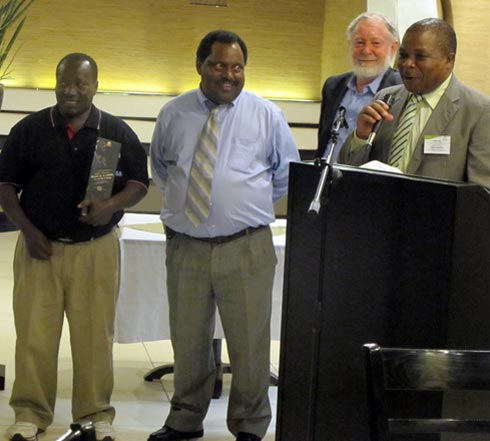 Speaking at the SIMLESA’s second “birthday party,” Joana Hewitt, chairperson of the ACIAR Commission for International Agricultural Research, reiterated the Australian government’s commitment to long-term partnerships with African governments. Participants also heard of the new SIMLESA Program in Zimbabwe, focusing on crop-livestock interactions. During the dinner, Kenya and Mozambique were recognized for their efforts in promoting and strengthening local innovation platforms.
Speaking at the SIMLESA’s second “birthday party,” Joana Hewitt, chairperson of the ACIAR Commission for International Agricultural Research, reiterated the Australian government’s commitment to long-term partnerships with African governments. Participants also heard of the new SIMLESA Program in Zimbabwe, focusing on crop-livestock interactions. During the dinner, Kenya and Mozambique were recognized for their efforts in promoting and strengthening local innovation platforms.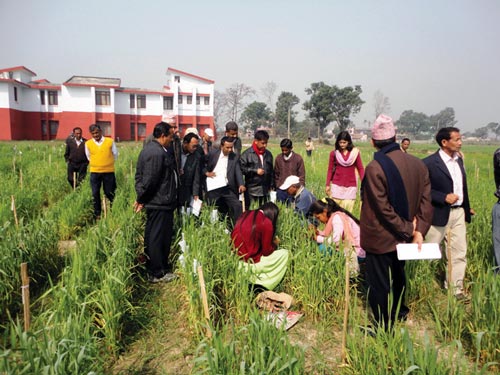 A training program on wheat participatory variety selection (PVS) was held in Nepal during 28-29 February 2012. Organized by the National Wheat Research Program (NWRP), Bhairahawa, Nepal Agriculture Research Council (NARC) and CIMMYT, the event attracted 17 scientists, technical officers and seed technicians from NARC’s research stations and private seed companies. The two-day training program focused on current challenges of wheat breeding and production in Nepal, wheat diseases, and participatory selection of varieties.
A training program on wheat participatory variety selection (PVS) was held in Nepal during 28-29 February 2012. Organized by the National Wheat Research Program (NWRP), Bhairahawa, Nepal Agriculture Research Council (NARC) and CIMMYT, the event attracted 17 scientists, technical officers and seed technicians from NARC’s research stations and private seed companies. The two-day training program focused on current challenges of wheat breeding and production in Nepal, wheat diseases, and participatory selection of varieties.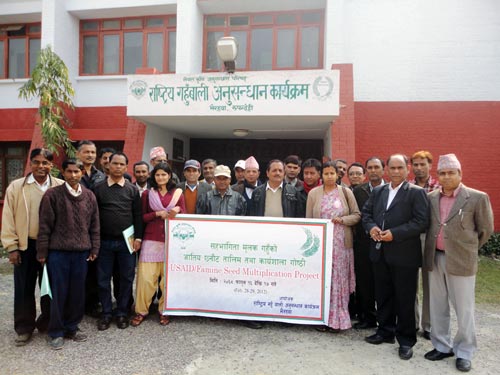 NARC scientists SR Upadhyay and NR Gautam explained the steps of participatory selection and participants scored varieties in the mother trial.
NARC scientists SR Upadhyay and NR Gautam explained the steps of participatory selection and participants scored varieties in the mother trial.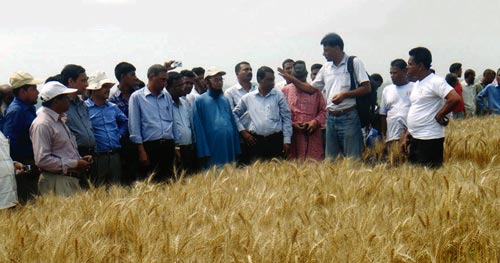
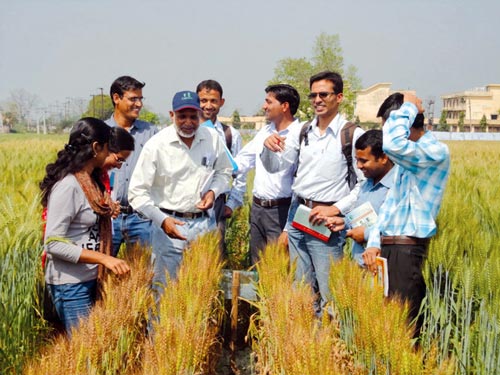 A one-day field training on scoring for spot blotch was organized on 17 March 2012 at the Borlaug Institute for South Asia (BISA) experiment station in Pusa, Bihar. Participants were 16 young scientists and students of Rajendra Agricultural University (RAU) and the Regional Station of Indian Agriculture Research Institute (IARI). Renowned pathologist Professor Ramesh Chand, Banaras Hindu University, was the main resource person, supported by Dr. Rajeev Kumar (RAU) and Raj Kumar Jat (CIMMYT).
A one-day field training on scoring for spot blotch was organized on 17 March 2012 at the Borlaug Institute for South Asia (BISA) experiment station in Pusa, Bihar. Participants were 16 young scientists and students of Rajendra Agricultural University (RAU) and the Regional Station of Indian Agriculture Research Institute (IARI). Renowned pathologist Professor Ramesh Chand, Banaras Hindu University, was the main resource person, supported by Dr. Rajeev Kumar (RAU) and Raj Kumar Jat (CIMMYT).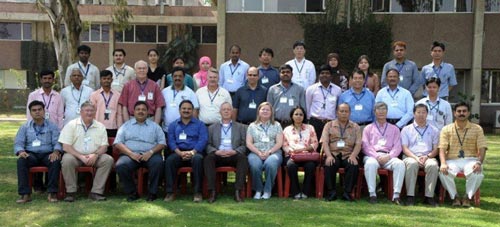
 On 15 February 2012, CIMMYT director general Tom Lumpkin met with his peer, Nteranya Sanginga, at the headquarters of the International Institute of Tropical Agriculture (IITA) in Ibadan, Nigeria. Accompanied by CIMMYT-Regional Liaison Officer, Wilfred Mwangi, Lumpkin also interacted with IITA maize breeders Baffour Badu-Apraku, Abebe Menkir, and Sam Ajala, as well as IITA socioeconomist Tahirou Abdoulaye.
On 15 February 2012, CIMMYT director general Tom Lumpkin met with his peer, Nteranya Sanginga, at the headquarters of the International Institute of Tropical Agriculture (IITA) in Ibadan, Nigeria. Accompanied by CIMMYT-Regional Liaison Officer, Wilfred Mwangi, Lumpkin also interacted with IITA maize breeders Baffour Badu-Apraku, Abebe Menkir, and Sam Ajala, as well as IITA socioeconomist Tahirou Abdoulaye.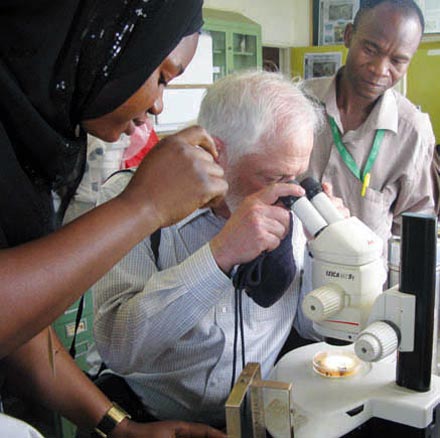 Lumpkin and Mwangi visited IITA maize trials, including those of maize bred for resistance to the parasitic flowering plant, Striga spp., through crosses with teosinte. Attaching to sprouting maize seedlings, Striga saps nutrients and imparts a toxin that slows growth. It causes damage to Africa’s maize estimated in the billions of dollars and affects as much as 40 million hectares of food crops across the region. Teosinte belongs to the same genus as maize and is considered the crop’s predecessor.
Lumpkin and Mwangi visited IITA maize trials, including those of maize bred for resistance to the parasitic flowering plant, Striga spp., through crosses with teosinte. Attaching to sprouting maize seedlings, Striga saps nutrients and imparts a toxin that slows growth. It causes damage to Africa’s maize estimated in the billions of dollars and affects as much as 40 million hectares of food crops across the region. Teosinte belongs to the same genus as maize and is considered the crop’s predecessor. All of us who work at CIMMYT have noticed its recent growth—new faces, new projects, and new facilities being constructed at El Batán and elsewhere. All of this means more research is getting done, and, inparticular, the global maize program is using and producing more breeding materials.
All of us who work at CIMMYT have noticed its recent growth—new faces, new projects, and new facilities being constructed at El Batán and elsewhere. All of this means more research is getting done, and, inparticular, the global maize program is using and producing more breeding materials. Tunga Silvar grows maize to feed his wife and fourgrandchildren on about 0.5 hectares of land in Mawanga, Zimbabwe, a hilly area some 45 kilometers northeast of Harare. Like otherfarmers in the region, he is acutely aware of the value of nitrogen fertilizer, continually juggles his limited household financesto get it, and is poorer and hungrier when he can’t. “We used to sell maize, but in the last five years we haven’t been able to do so,” saysSilvar. “I had to pay school fees for my grandchildren, so I couldn’t buy fertilizer. Fertilizer is very important, especially in our type of soil. If you don’t apply it, youcan barely harvest anything.”
Tunga Silvar grows maize to feed his wife and fourgrandchildren on about 0.5 hectares of land in Mawanga, Zimbabwe, a hilly area some 45 kilometers northeast of Harare. Like otherfarmers in the region, he is acutely aware of the value of nitrogen fertilizer, continually juggles his limited household financesto get it, and is poorer and hungrier when he can’t. “We used to sell maize, but in the last five years we haven’t been able to do so,” saysSilvar. “I had to pay school fees for my grandchildren, so I couldn’t buy fertilizer. Fertilizer is very important, especially in our type of soil. If you don’t apply it, youcan barely harvest anything.”
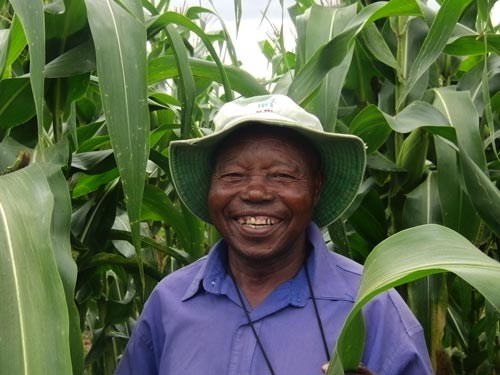 Late and erratic rainfall in Zimbabwe has many farmers facing the prospect of poor harvests. The current hardships from drought though may furnish some hopefor farmers. New drought tolerant varieties are being tested in on-farm trials under farmer management. Many of the trials are experiencing drought stress—aperfect opportunity to identify the best varieties for such harsh conditions. A recent visit to on-farm trials in the Murewa District of Zimbabwe showed many new drought tolerant products performing well. Local farmer Sailas Ruswa is growing a trial and was enthusiastic about what he saw: some varieties showedsigns of severe drought stress, but a few were holding up well and were expected to produce good yields.
Late and erratic rainfall in Zimbabwe has many farmers facing the prospect of poor harvests. The current hardships from drought though may furnish some hopefor farmers. New drought tolerant varieties are being tested in on-farm trials under farmer management. Many of the trials are experiencing drought stress—aperfect opportunity to identify the best varieties for such harsh conditions. A recent visit to on-farm trials in the Murewa District of Zimbabwe showed many new drought tolerant products performing well. Local farmer Sailas Ruswa is growing a trial and was enthusiastic about what he saw: some varieties showedsigns of severe drought stress, but a few were holding up well and were expected to produce good yields.
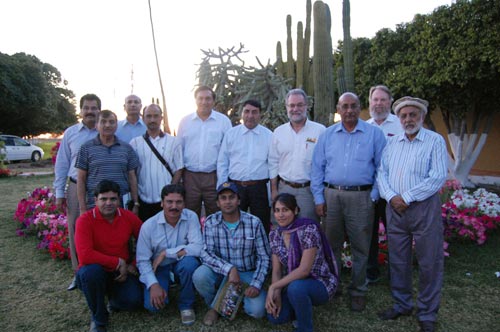 For some attendees, the unveiling of the new Norman E. Borlaug statue at CENEB was particularly poignant. It was a young Pakistani researcher who, in 1961, selected the variety that later became known asMexipak; a high-yielding, white grain wheat that became one of the mega-varieties that launched the Green Revolution. In 1966, Pakistan imported 41,000tons of Mexipak seed from Mexico – one of the biggest seed imports in history. Quarantine restrictions would make this a difficult task today, but it is estimated thatthis large-scale mission saved one million people from starvation and famine during the Green Revolution.
For some attendees, the unveiling of the new Norman E. Borlaug statue at CENEB was particularly poignant. It was a young Pakistani researcher who, in 1961, selected the variety that later became known asMexipak; a high-yielding, white grain wheat that became one of the mega-varieties that launched the Green Revolution. In 1966, Pakistan imported 41,000tons of Mexipak seed from Mexico – one of the biggest seed imports in history. Quarantine restrictions would make this a difficult task today, but it is estimated thatthis large-scale mission saved one million people from starvation and famine during the Green Revolution.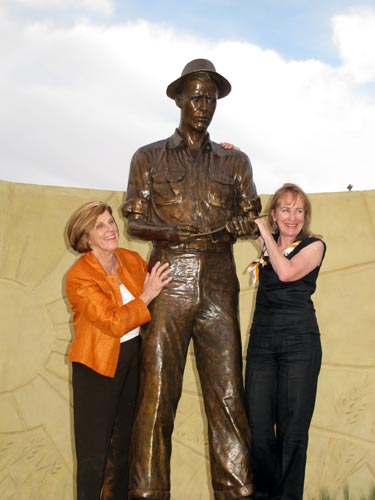 On 25 March 2012, CIMMYT celebrated what would have been Norman Borlaug’s 98th birthday with the unveiling of a new statue at CENEB, Ciudad Obregón, Mexico. CIMMYT Director General, Thomas Lumpkin, presented this tribute to the “Father of the Green Revolution” in front of a crowd of over 100 people from 34 countries, which together produce 97 percent of the world’s wheat.
On 25 March 2012, CIMMYT celebrated what would have been Norman Borlaug’s 98th birthday with the unveiling of a new statue at CENEB, Ciudad Obregón, Mexico. CIMMYT Director General, Thomas Lumpkin, presented this tribute to the “Father of the Green Revolution” in front of a crowd of over 100 people from 34 countries, which together produce 97 percent of the world’s wheat.